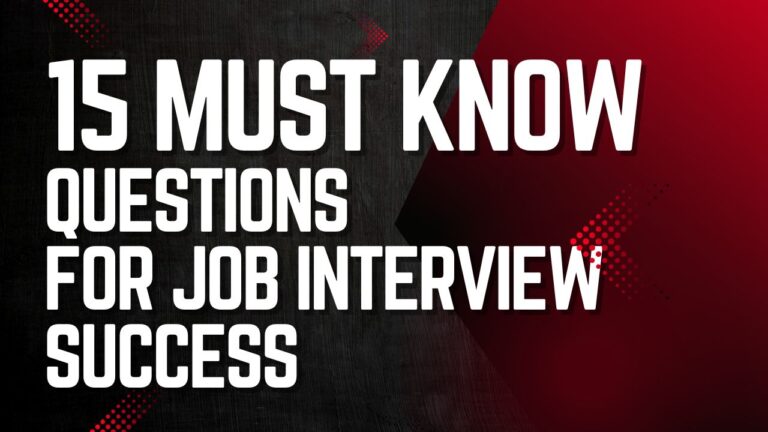55 Interview Questions BMO Financial Group: Client Service Assistant (with Sample Answers)

BMO Financial Group is hiring a Client Service Assistant to support Investment Advisors (IAs) and their teams in delivering exceptional client service. This post covers 50+ Interview Questions for the Role of Client Service Assistant BMO Financial Group.
This role is ideal for individuals with strong organizational, communication, and problem-solving skills, looking to grow their careers in wealth management and financial services. As part of the advisory team, the Client Service Assistant will handle daily administrative tasks, client interactions, and marketing activities, ensuring smooth branch operations.

We found the Job Listing at https://jobs.bmo.com/ca/en
For Linkedin post: BMO Financial Group Vacancy
If you are detail-oriented, enjoy working in a fast-paced, client-focused environment, and want to be part of a leading financial institution, this could be the perfect opportunity for you!
| Job Profile | Details |
|---|---|
| Role Name | Client Service Assistant |
| Salary | $32,700 – $48,600 per year (Salaried & Commission) |
| Location of Job | Multiple locations (based on branch assignments) |
| Hours of Work | Full-time, with flexible scheduling as per branch needs |
This table provides a quick overview of the key job details.
In this post we will cover 50+ Interview Questions covering general Interview Questions which are asked for Financial sector Job and also a list of Expected Questions for BMO Financial Group Client Service Assistant Job.
Please Note: This will be a tentative list which will help you to prepare for the Interview. The actual Interview Questions may vary.
Client Service Assistant Role at BMO Financial Group










This role is perfect for individuals looking to build a career in financial services while supporting a dynamic, client-focused team.

30 Common Interview Questions for Financial Institutions (With Sample Answers)
1. What do you consider the most important financial metrics when analyzing a company?
Sample Answer:
“I believe that key financial metrics such as Return on Equity (ROE), Debt-to-Equity Ratio, and Earnings Before Interest and Taxes (EBIT) are crucial. ROE indicates how effectively a company uses equity to generate profit, while the Debt-to-Equity Ratio helps assess financial leverage and risk. EBIT provides insight into operational performance without the influence of capital structure.”
2. How do you stay updated with financial regulations and compliance?
Sample Answer:
I regularly follow financial news sources, subscribe to industry newsletters, and participate in webinars and workshops.
Additionally, I am a member of professional organizations that provide updates on regulatory changes. This proactive approach ensures that I am aware of any shifts in compliance requirements that may impact our operations.

3. Can you explain the difference between a bond and a stock?
Sample Answer:
“A bond is a debt security where the issuer borrows funds from the investor and pays interest over time, returning the principal at maturity. In contrast, a stock represents ownership in a company, allowing shareholders to benefit from its profits through dividends and capital appreciation. Bonds are generally considered less risky than stocks, as they provide fixed income and priority in case of liquidation.”
4. Describe a time when you had to analyze complex financial data. What was your approach?
Sample Answer:
“In my previous role, I was tasked with analyzing a portfolio’s performance across various asset classes. I started by breaking down the data into manageable segments, using Excel to create pivot tables and charts for visualization. I then identified trends and variances, which I presented to senior management, suggesting reallocation strategies that ultimately improved returns by X%.”
5. How do you assess the creditworthiness of a borrower?
Sample Answer:
“I assess creditworthiness by analyzing several factors, including the borrower’s credit history, income stability, debt-to-income ratio, and overall financial health. I also consider external factors such as market conditions and economic indicators. This comprehensive approach allows me to make informed lending decisions while minimizing the risk.”
6. What strategies would you use to manage financial risk?
Sample Answer:
“To manage financial risk, I would employ a combination of diversification, hedging, and regular risk assessments. Diversifying investments across different asset classes can reduce exposure to market volatility.”
7. What is your experience with portfolio management?
Sample Answer:
“I have experience in portfolio management where I was responsible for constructing and managing a diversified investment portfolio for clients. My approach involved assessing client risk tolerance, investment goals, and market conditions. I regularly reviewed portfolio performance and made adjustments based on changing market dynamics and client needs, which resulted in consistently meeting or exceeding performance benchmarks.”
8. How would you handle a disagreement with a colleague regarding financial analysis?
Sample Answer:
“I would approach the disagreement by first seeking to understand my colleague’s perspective and the rationale behind their analysis. I believe in open communication, so I would suggest a collaborative review of the data to identify any discrepancies. If needed, we could involve a third party for an objective opinion, ensuring that the final decision is based on accurate information.”
9. What are your thoughts on sustainable investing, and how do you incorporate it into your strategies?
Sample Answer:
“I believe sustainable investing is increasingly important as investors become more aware of environmental, social, and governance (ESG) factors. I incorporate sustainable investing into my strategies by evaluating potential investments based on their ESG performance alongside traditional financial metrics. This approach not only aligns with ethical considerations but can also enhance long-term returns, as companies with strong ESG practices often demonstrate resilience and lower risk profiles.”
10. Can you explain the term ‘capital structure’ and its components?
Sample Answer:
“Capital structure refers to the mix of debt and equity financing used by a company to fund its operations and growth. The main components include long-term debt, short-term debt, preferred equity, and common equity. An optimal capital structure balances the cost of capital and financial risk, ultimately impacting a company’s valuation and return on investment.”
11. How do you evaluate investment opportunities?
Sample Answer:
“I evaluate investment opportunities by conducting thorough due diligence, including financial analysis, market research, and risk assessment. I utilize metrics such as ROI, internal rate of return (IRR), and payback period to quantify potential returns. Additionally, I consider qualitative factors like management quality and industry trends to ensure a holistic evaluation.”
12. What role does diversification play in an investment portfolio?
Sample Answer:
“Diversification plays a critical role in reducing risk in an investment portfolio. By spreading investments across various asset classes, sectors, and geographical regions, I can mitigate the impact of poor performance in any single investment. This strategy aims to enhance overall returns while minimizing volatility.”
13. Describe your experience with financial modeling.
Sample Answer:
“I have extensive experience in financial modeling, particularly in building models for forecasting revenues, expenses, and cash flows. In my last role, I developed a three-statement model that integrated income statements, balance sheets, and cash flow statements. This model was used for scenario analysis and informed strategic decisions, such as potential acquisitions.”
14. How do you approach budgeting and forecasting?
Sample Answer:
“My approach to budgeting and forecasting involves collaboration with various departments to gather input on expected revenues and expenses. I utilize historical data and market trends to create realistic projections. I also implement a rolling forecast to adapt to changing circumstances and ensure that the organization remains aligned with its financial goals.”
15. Describe a situation where you had to present complex financial information to a non-financial audience.
Sample Answer:
“In a previous role, I was tasked with presenting our annual financial performance to the board of directors, many of whom did not have a financial background. I focused on simplifying complex data by using visual aids such as charts and graphs. I highlighted key metrics and trends while avoiding jargon, ensuring that the audience could grasp the essential points. The presentation was well-received, and I received positive feedback for making the information accessible.”
16. How would you assess the impact of interest rate changes on a financial institution?
Sample Answer:
“I would assess the impact of interest rate changes by analyzing the institution’s asset-liability management strategy. This includes evaluating the sensitivity of the loan portfolio and investment securities to interest rate fluctuations. Additionally, I would consider the potential effects on net interest margins and overall profitability, using stress testing to gauge resilience under different scenarios.”
17. What is the purpose of a financial audit?
Sample Answer:
“The purpose of a financial audit is to provide an independent assessment of an organization’s financial statements, ensuring accuracy and compliance with accounting standards. It enhances transparency and builds trust with stakeholders, including investors and regulators. An audit can also identify areas for operational improvement and risk management.”
18. How do you prioritize tasks when managing multiple financial projects?
Sample Answer:
“I prioritize tasks by assessing their urgency and impact on overall business objectives. I use project management tools to create a timeline and allocate resources effectively. Regular check-ins with stakeholders help ensure alignment, and I remain flexible to adjust priorities as needed based on changing circumstances or new information.”
19. What experience do you have with financial software and tools?
Sample Answer:
“I have experience with various financial software, including Excel for data analysis and modeling, QuickBooks for accounting, and SAP for enterprise resource planning. Additionally, I am familiar with Bloomberg Terminal for market analysis and financial research. My proficiency with these tools enhances my ability to analyze data efficiently and make informed decisions.”
20. Explain the concept of working capital and its significance.
Sample Answer:
“Working capital is the difference between a company’s current assets and current liabilities. It is significant because it measures a company’s short-term liquidity and operational efficiency. Adequate working capital ensures that a business can meet its short-term obligations and invest in day-to-day operations, which is crucial for maintaining smooth operations.”
21. How do you handle financial discrepancies in reports?
Sample Answer:
“When I encounter financial discrepancies, I first conduct a thorough review of the relevant data to identify the source of the error. I communicate with team members involved in the reporting process to gather insights. Once I pinpoint the issue, I make the necessary corrections and implement additional checks to prevent future discrepancies.”
22. What is your experience with risk assessment and management?
Sample Answer:
“I have significant experience in risk assessment and management, particularly in identifying financial risks related to credit, market fluctuations, and operational inefficiencies. I conduct regular risk assessments using quantitative and qualitative methods to evaluate potential impacts. I also develop risk mitigation strategies, such as diversifying investments and implementing robust internal controls.”
23. How do you ensure compliance with financial regulations?
Sample Answer:
“I ensure compliance with financial regulations by staying informed about relevant laws and guidelines through continuous education and training. I implement internal controls and regular audits to monitor compliance. Additionally, I foster a culture of compliance within the organization by providing training to employees on regulatory requirements and best practices.”
24. What is the importance of a cash flow statement?
Sample Answer:
“The cash flow statement is essential because it provides insight into a company’s liquidity and cash management. It outlines cash inflows and outflows from operating, investing, and financing activities, helping stakeholders assess the company’s ability to generate cash, meet obligations, and fund growth. It complements the income statement and balance sheet for a comprehensive financial analysis.”
25. Describe a financial project you led and the outcome.
Sample Answer:
“I led a project to streamline our budgeting process, which involved implementing a new financial software system. I coordinated with IT and finance teams to ensure a smooth transition. As a result, we reduced the budgeting cycle time by 30% and improved accuracy, enabling more timely decision-making and better resource allocation.”
26. How do you evaluate the performance of a financial institution?
Sample Answer:
“I evaluate the performance of a financial institution by analyzing key performance indicators (KPIs) such as return on assets (ROA), return on equity (ROE), net interest margin, and efficiency ratio. I also consider qualitative factors like customer satisfaction and regulatory compliance. A holistic approach provides a comprehensive view of the institution’s health and effectiveness.”
27. What is your approach to ethical decision-making in finance?
Sample Answer:
“My approach to ethical decision-making involves adhering to established codes of conduct and regulatory requirements. I prioritize transparency and integrity in all financial dealings. When faced with ethical dilemmas, I seek guidance from senior management or compliance officers and consider the long-term implications of my decisions on stakeholders and the organization’s reputation.”
28. How do you manage relationships with clients or stakeholders in a financial setting?
Sample Answer:
“I manage relationships with clients and stakeholders by prioritizing clear communication and trust-building. I make it a point to understand their goals and concerns, which allows me to tailor my approach to meet their needs. Regular check-ins and updates help maintain transparency, and I actively seek feedback to improve our services. By fostering a collaborative environment, I can ensure that all parties feel valued and informed throughout our interactions.”
29. How do you approach team collaboration in financial projects?
Sample Answer:
“I approach team collaboration by fostering open communication and ensuring that all team members understand their roles and responsibilities. I encourage brainstorming sessions to gather diverse perspectives and promote a culture of inclusivity. Regular updates and feedback loops help keep the project on track and allow for adjustments based on team input.”
30. What do you believe are the biggest challenges facing the financial industry today?
Sample Answer:
“I believe the biggest challenges facing the financial industry today include regulatory compliance, technological disruption, and cybersecurity threats. As regulations become more stringent, institutions must ensure compliance while maintaining operational efficiency. Additionally, the rise of fintech companies is reshaping the landscape, requiring traditional institutions to innovate and adapt to stay competitive. Cybersecurity remains a critical concern as financial data becomes increasingly vulnerable to breaches.”
Here’s a list of 25 interview questions tailored for the Client Service Assistant position at BMO Financial Group, along with sample answers to help you prepare:
List of 25 interview questions: Client Service Assistant BMO Financial Group

1. Can you describe your experience in client service roles?
Sample Answer:
“I have worked in client service for over X years, where I developed strong communication and problem-solving skills. In my previous role, I managed client inquiries and supported a team of financial advisors, ensuring timely and accurate responses to client needs. This experience taught me the importance of building relationships and providing exceptional service.”
2. How do you prioritize tasks when supporting multiple advisors?
Sample Answer:
“I prioritize tasks by assessing urgency and impact. I maintain a task list and categorize items based on deadlines and importance. For instance, if an advisor needs documents urgently for a client meeting, I ensure that takes precedence while still managing other ongoing tasks.”
3. Describe a time when you handled a difficult client situation.
Sample Answer:
“I once dealt with a client who was frustrated about a delay in their account transfer. I listened to their concerns, empathized with their situation, and assured them I would follow up immediately. I contacted the relevant department, expedited the process, and kept the client informed throughout. This approach turned their frustration into appreciation, and they expressed gratitude for my support.”
4. What do you know about BMO Financial Group and its values?
Sample Answer:
“BMO Financial Group is committed to creating positive change through its purpose. I admire BMO’s focus on community engagement and inclusivity, as well as its emphasis on innovation and collaboration. I believe these values align with my own commitment to providing exceptional client service and making a meaningful impact.”
5. How do you ensure confidentiality and security when handling client information?
Sample Answer:
“I understand the critical importance of confidentiality in the financial industry. I ensure that all client information is stored securely, follow established protocols for data access, and never discuss sensitive information in public settings. Additionally, I stay updated on compliance regulations to protect client privacy.”
6. Can you explain your familiarity with financial products?
Sample Answer:
“I have a foundational understanding of various financial products, including stocks, bonds, mutual funds, and managed accounts. My coursework in finance and my previous roles have equipped me with knowledge of how these products work and their potential benefits for clients, which I can leverage to assist the advisory team effectively.”
7. How do you handle technology issues when assisting clients?
Sample Answer:
“When clients encounter technology issues, I first listen carefully to understand the problem. I then guide them through troubleshooting steps, ensuring they feel supported. If the issue persists, I escalate it to the appropriate technical support team while keeping the client informed throughout the process.”
8. Describe your experience with organizing client events.
Sample Answer:
“In my previous role, I assisted in organizing client appreciation events, including venue selection, catering, and communication with attendees. I focused on creating an inviting atmosphere that fostered relationship-building. The events were well-received, and many clients expressed their appreciation for the personal touch we provided.”
9. How do you maintain an organized client database?
Sample Answer:
“I maintain an organized client database by regularly updating information and categorizing clients based on their needs and preferences. I use consistent naming conventions and tags to make searching for specific clients efficient. Additionally, I conduct periodic reviews to ensure data accuracy and completeness.”
10. What strategies do you use to build rapport with clients?
Sample Answer:
“I build rapport with clients by actively listening to their needs, showing empathy, and personalizing interactions. I make an effort to remember details about their lives, such as birthdays or interests, which helps create a more meaningful connection. This approach fosters trust and encourages open communication.”
11. How do you ensure compliance with regulatory requirements in your role?
Sample Answer:
“I ensure compliance by staying informed about relevant regulations and company policies. I regularly review guidelines and participate in training sessions to enhance my understanding. Additionally, I double-check all transactions and documentation to confirm they meet compliance standards before processing.”
12. Can you provide an example of a report you generated for an advisor?
Sample Answer:
“I recently generated a performance report for an advisor that included client account summaries, transaction histories, and market comparisons. I used Excel to analyze the data and create visual representations, making it easier for the advisor to present to clients. The report was well-received and facilitated productive discussions during client meetings.”
13. How do you handle competing priorities in a fast-paced environment?
Sample Answer:
“I thrive in fast-paced environments by staying organized and maintaining flexibility. I use a task management system to track deadlines and prioritize based on urgency. If unexpected tasks arise, I assess their impact and adjust my priorities accordingly, ensuring that critical responsibilities are met without compromising quality.”
14. What role do you think technology plays in improving client service?
Sample Answer:
“Technology plays a crucial role in enhancing client service by streamlining processes and improving communication. Tools such as CRM software allow for better tracking of client interactions, while digital communication platforms enable timely responses. By leveraging technology, we can provide a more efficient and personalized experience for clients.”
15. How would you approach a situation where you don’t know the answer to a client’s question?
Sample Answer:
“If I don’t know the answer to a client’s question, I would first acknowledge their inquiry and assure them that I will find the information they need. I would then either consult with a team member who has the expertise or conduct research to provide an accurate response. Following up with the client promptly is essential to maintain their trust.”
16. Describe your experience with account opening and updates.
Sample Answer:
“I have experience assisting clients with account openings and updates, including guiding them through the necessary documentation and compliance requirements. I ensure that all information is accurately captured and processed in a timely manner. My attention to detail helps prevent errors and enhances the overall client experience.”
17. How do you approach learning about new financial products or services?
Sample Answer:
“I approach learning about new financial products by actively seeking out training opportunities, attending workshops, and reading industry publications. I also engage with colleagues to share insights and experiences. Staying informed helps me better assist clients and support the advisory team with relevant information.”
18. What qualities do you believe are essential for a successful Client Service Assistant?
Sample Answer:
“Essential qualities for a successful Client Service Assistant include strong communication skills, attention to detail, and a proactive attitude. Being empathetic and client-focused is also crucial, as it helps build trust and fosters positive relationships. Additionally, adaptability and problem-solving skills are important in addressing client needs effectively.”
19. How do you keep track of marketing activities for the advisory team?
Sample Answer:
“I keep track of marketing activities by creating a marketing calendar that outlines upcoming events, social media posts, and client recognition initiatives. I use project management tools to ensure all tasks are assigned and deadlines are met. Regular check-ins with the advisory team help us stay aligned on our marketing goals.”
20. Can you explain the importance of client recognition in your role?
Sample Answer:
“Client recognition is vital in building long-term relationships and demonstrating appreciation for their loyalty. Celebrating meaningful life events, such as anniversaries or milestones, helps clients feel valued and strengthens their connection with our advisory team. It can lead to increased client satisfaction and retention.”
21. How do you ensure effective communication within your team?
Sample Answer:
“I ensure effective communication within my team by promoting an open-door policy where team members feel comfortable sharing ideas and updates. I also facilitate regular team meetings to discuss ongoing projects and challenges, ensuring everyone is aligned. Utilizing collaboration tools helps keep communication organized and accessible.”
22. Describe a time when you went above and beyond for a client.
Sample Answer:
“I once had a client who needed urgent assistance with a wire transfer for a time-sensitive investment. I took the initiative to personally follow up with the processing team to expedite the transfer. I kept the client informed throughout the process, and they were extremely grateful for my proactive approach, which solidified their trust in our services.”
23. What steps do you take to stay organized in your daily tasks?
Sample Answer:
“I stay organized by starting each day with a prioritized to-do list that outlines my tasks and deadlines. I use digital tools to track progress and set reminders for important follow-ups. Regularly reviewing my list helps me adjust priorities as needed and ensures that nothing falls through the cracks.”
24. How do you handle feedback or criticism from supervisors?
Sample Answer:
“I view feedback and criticism as opportunities for growth. When I receive constructive feedback, I listen carefully, ask clarifying questions if necessary, and reflect on how I can improve. I appreciate guidance that helps me enhance my skills and performance, and I actively implement suggestions in my work.”
25. Why do you want to work as a Client Service Assistant at BMO Financial Group?
Sample Answer:
“I want to work as a Client Service Assistant at BMO Financial Group because I admire the company’s commitment to creating positive change and its focus on client relationships. I believe my skills in client service and my passion for the financial industry align well with BMO’s values. I am excited about the opportunity to contribute to a team that prioritizes exceptional service and community engagement.”
These questions and answers should help you prepare effectively for an interview for the Client Service Assistant position at BMO Financial Group.
Good luck!






